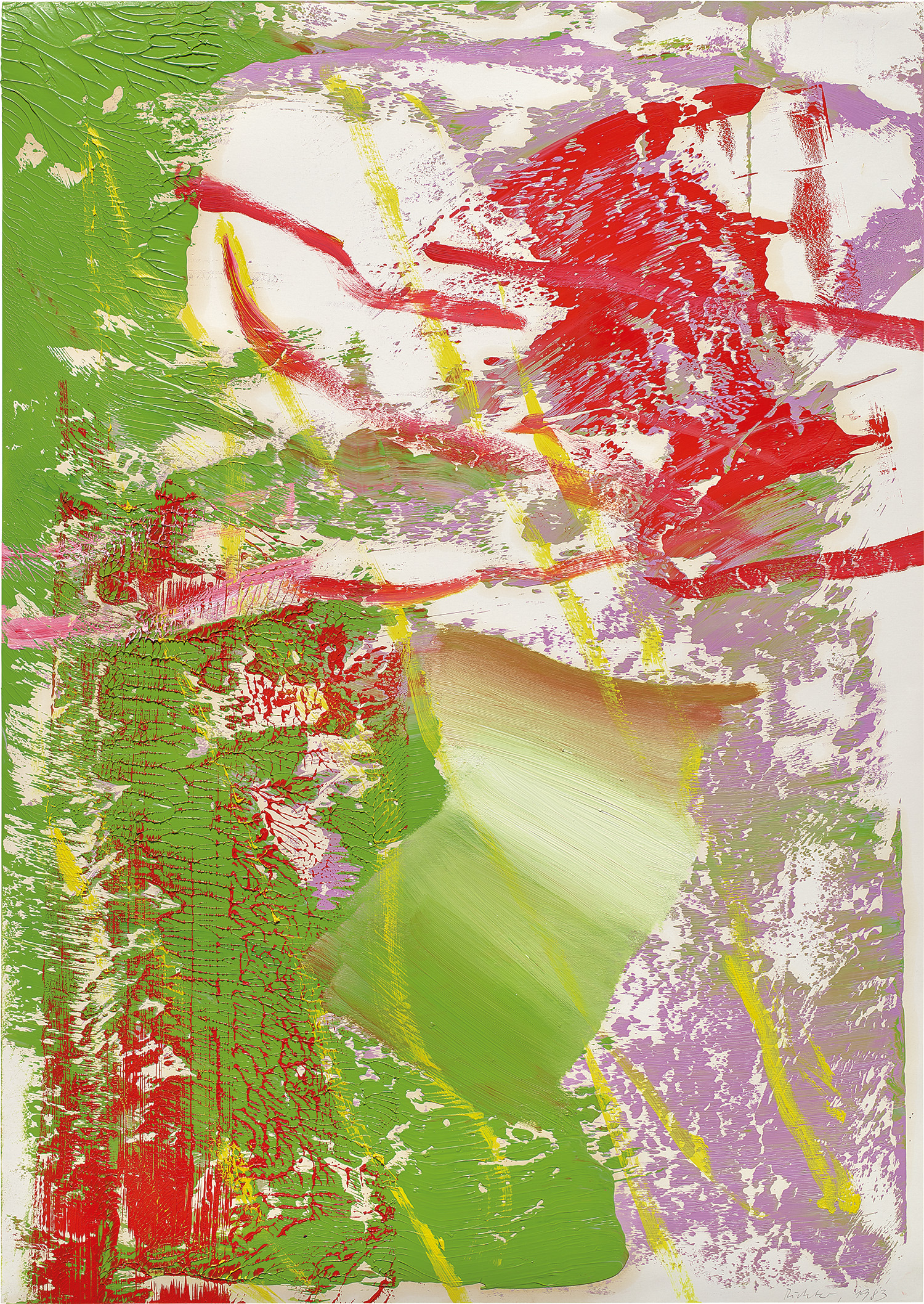

167
Gerhard Richter
Donnerstag
Full-Cataloguing
In Gerhard Richter’s Donnerstag, 1983, paint meets paper with incredible dynamism and force. Broad sweeps of the heavily loaded brushstroke collide with energetic lines across the vast surface, which Richter has covered in delicate veils of mottled paint through his signature squeegee technique. A powerful example of Richter’s early Abstrakte Bilder (Abstract Paintings), Donnerstag is characterized by a formal rigor and a chromatic and compositional complexity that matches Richter’s best works. A true masterwork on paper, Donnerstag is exemplary of the vigor with which Richter pushed the genre of abstraction to new aesthetic and conceptual realms.
It was in the summer of 1976 that Richter began his Abstrakte Bilder series, creating his tour-de-force painting Konstruktion without any premediation in terms of drawings or smaller paintings. A bold and sudden departure from his series of Graue Bilder (Gray Paintings) that had occupied him for the preceding decade, these Abstrakte Bilder declared a radical new stage in Richter’s oeuvre. Expanding on his Color Charts and Rot-Blau-Gelb series, Richter began embracing vibrant color and the generative potential of chance to create explosive constellations that flew in the face of all tradition. While Richter initially took projections of abstract motifs as a point of departure, by 1981 he had achieved a masterful freehand application of paint to create abstract pictorial spaces in which the materiality of painting takes center stage.
Donnerstag demonstrates Richter’s burgeoning exploration of the squeegee, whereby he would use a home-made squeegee to drag and scrape large bands of wet-on-wet paint across the surface to produce unpredictable patterns of color and quasi-mechanical palimpsests of layered and scraped down color. Widely celebrated as Richter’s single most innovative contribution to the history of painting, the squeegee technique effectively saw Richter further develop the haptic swirls of painting that canceled out the photorealistic images in his early work, such as Tisch (Table), 1962. As Dietmar Elger observed, the squeegee, "is the most important implement for integrating coincidence into his art. For years, he used it sparingly, but he came to appreciate how the structure of paint applied with a squeegee can never be completely controlled. It thus introduces a moment of surprise that often enables him to extricate himself from a creative dead-end, destroying a prior, unsatisfactory effort and opening the door to a fresh start” (Dietmar Elger, Gerhard Richter: A Life in Painting, Chicago, 2009, p. 251).
Executed in 1983, the present work is an example of Richter’s so-called “Free Abstracts”, in which Richter oscillates between the chance structure offered by the squeegee and the controlled, confident gesture of his own brushwork that here crisscrosses and tumbles across the surface in the form of ribbons and broad strokes. As Richter crucially pointed out, “above all, it’s never blind chance: it’s a chance that’s always planned, but also always surprising. And I need it in order to carry on, in order to eradicate my mistakes, to destroy what I’ve worked out wrong, to introduce something different and disruptive” (Gerhard Richter, quoted in Hans Ulrich Obrist, ed., Gerhard Richter: The Daily Practice of Painting – Writings 1962-1993, London, 1995, p. 159). Richter’s abstract paintings are constructed with a structure in mind, but ultimately, individual cadences of both dissonant and consonant color take on a life of their own.
The notion of planned chance takes on particular significance given Richter’s choice of working with oil on paper, a medium that offers immediacy but also allows for little margin of re-working or layering. “Drawing or painting on paper is more impulsive than painting on canvas,” Richter explained. “It’s less possible to control and that makes the work more intimate, and closer to your feelings. Another thing that fascinates me is that the whiteness of paper creates a space that is different from canvas” (Gerhard Richter, “Interview with Anna Tilroe”, 1987, in Dietmar Elger and Hans-Ulrich Obrist, eds., Gerhard Richter – Text. Writings, Interviews and Letters 1961-2007, London, 2009, p. 192). While many of Richter’s works on paper tend to be titled after the approximate date they were created – heightening the sense of immediacy inherent to their creation – Donnerstag belongs to the discrete body of work Richter titled after certain days in the week. As with the related works Montag (Monday), Dienstag (Tuesday), and Mittwoch (Wednesday), this work brilliantly plays into the passage of time inherent to the process of painting.
Exhibited at Marian Goodman’s Drawings group show in New York in 1983, Donnerstag powerfully speaks to an artist at the precipice of international acclaim. After the exhibition, which was his first showing at the gallery, Richter would go on to receive his first solo exhibition at Marian Goodman Gallery, New York, in 1985, ushering in a period of international exhibitions that would culminate in his breakthrough exhibition at the Tate, London, in 1991. Donnerstag celebrates an artist at his prime, one who would push his pictorial innovations from the past decades into astonishing heights with his ensuing Abstrakte Bilder.
Gerhard Richter
German | 1932Powerhouse painter Gerhard Richter has been a key player in defining the formal and ideological agenda for painting in contemporary art. His instantaneously recognizable canvases literally and figuratively blur the lines of representation and abstraction. Uninterested in classification, Richter skates between unorthodoxy and realism, much to the delight of institutions and the market alike.
Richter's color palette of potent hues is all substance and "no style," in the artist's own words. From career start in 1962, Richter developed both his photorealist and abstracted languages side-by-side, producing voraciously and evolving his artistic style in short intervals. Richter's illusory paintings find themselves on the walls of the world's most revered museums—for instance, London’s Tate Modern displays the Cage (1) – (6), 2006 paintings that were named after experimental composer John Cage and that inspired the balletic 'Rambert Event' hosted by Phillips Berkeley Square in 2016.